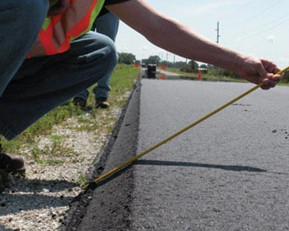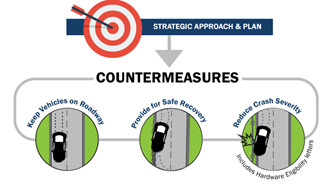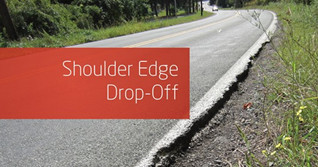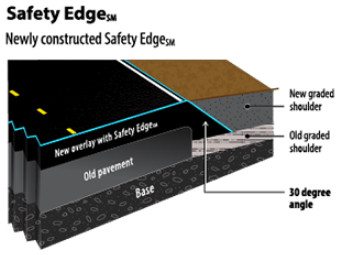Roadway Departure Safety (Part 2 of 3)
Edited by Airton G. Kohls and Matt Cate (Source: FHWA Office of Safety)

This article is the second of three articles we will be using in 2019 to highlight resources that can help your agency reduce roadway departure (RwD) crashes, which are defined as crashes that occur after a vehicle crosses an edge line or a center line, or otherwise leaves the traveled way. Roadway departure crashes encompass a variety of crash scenarios, including collisions between vehicles traveling in opposite directions on the same roadway, vehicles striking terrain and drainage features, and collisions with fixed objects such as trees and utility poles.
Here, we will focus on countermeasures to provide for safe recovery of vehicles to the roadway. It is one of the efforts presented on the FHWA’s Strategic Approach & Plan that also includes strategies to keep vehicles on the roadway and to reduce crash severity.
Countermeasures to Provide for Safe Recovery
Roadway departures account for over half of all fatal crashes. Once vehicles have left the travel lane, providing an opportunity to reenter the travel way safely is a priority. Providing shoulders, safe pavement edges, and clear zones are effective means in which agencies can provide the opportunity for drivers to recover safely.

Safety Edge SM
The Safety Edge SM is a simple but extremely effective solution that can help save lives by allowing drivers who drift off the travel way to return to the road safely. When installed properly, simply consolidating the edge of the pavement to 30-degree shape during the paving process can eliminate the problem of vertical edge drop-off.
Key benefits of the Safety Edge SM. technology include:
- Its ability to saves lives by allowing vehicles to safely return to the travel lane and mitigate pavement edge drop-off.
- An improvement can be seen in pavement durability by reducing edge raveling.
- Its cost is low, which is attributed to the addition of typically less than 1 percent of the project’s total asphalt quantity.
 Figure 1 - Exposed pavement edge.
Figure 1 - Exposed pavement edge.
Courtesy: Robson ForensicThe Safety Edge SM shape ensures that tire scrubbing will not occur when the pavement edge is exposed (see Figure 1 below). SafetyEdge. can be added to both asphalt and concrete pavement projects. Figure 2 presents a diagram of a newly constructed Safety Edge SM. Notice that even if erosion exists on the shoulder material the Safety Edge SM provides a smoother recovery to the roadway. For additional information on the Safety Edge SM, please go to: https://safety.fhwa.dot.gov/safetyEdge/
 Figure 2 - Safety Edge SM with new graded shoulder. Courtesy: FHWA
Figure 2 - Safety Edge SM with new graded shoulder. Courtesy: FHWAClear Zones
By creating Clear Zones, roadway agencies can increase the likelihood that a roadway departure results in a safe recovery rather than a crash, and mitigate the severity of crashes that do occur. A Clear Zone is an unobstructed, traversable roadside area that allows a driver to stop safely, or regain control of a vehicle that has left the roadway. Clear Zones
Clear ZonesFAQ on Clear Zones
What is the definition of clear zone?
The Roadside Design Guide defines a clear zone as the total roadside border area, starting at the edge of the traveled way, available for safe use by errant vehicles. This area may consist of a shoulder, a recoverable slope, a non-recoverable slope, and/or a clear run-out area. The desired minimum width is dependent upon traffic volumes and speeds and on the roadside geometry. Simply stated, it is an unobstructed, relatively flat area beyond the edge of the traveled way that allows a driver to stop safely or regain control of a vehicle that leaves the traveled way. A recoverable slope is a slope on which a motorist may, to a greater or lesser extent, retain or regain control of a vehicle by slowing or stopping. Slopes flatter than 1V:4H are generally considered recoverable. A non-recoverable slope is a slope which is considered traversable but on which an errant vehicle will continue to the bottom. Embankment slopes between 1V:3H and 1V:4H may be considered traversable but non-recoverable if they are smooth and free of fixed objects. A clear run-out area is the area at the toe of a non-recoverable slope available for safe use by an errant vehicle. Slopes steeper than 1V:3H are not considered traversable and are not considered part of the clear zone.Where can I find information on clear zone dimensions?
The current edition of the AASHTO Roadside Design Guide presents information on the latest state-of- the-practice in roadside safety. It presents procedures to determine a recommended minimum clear zone on tangent sections of roadway with variable side slopes and adjustments for horizontal curvature. The AASHTO A Policy on Geometric Design of Highways and Streets (Green Book) enumerates a clear zone value for two functional classes of highway. For local roads and streets, a minimum clear zone of 7 to 10 feet is considered desirable on sections without curb. In the discussion on collectors without curbs, a 10-foot minimum clear zone is recommended. The general discussion on Cross-section Elements also indicates a clear zone of 10 ft. for low-speed rural collectors and rural local roads should be provided.What is the definition of horizontal clearance?
Horizontal clearance is the lateral offset distance from the edge of the traveled way, shoulder or other designated point to a vertical roadside element. These dimensional values are not calculated, and are not intended to constitute a clear zone. They are intended to provide a roadside environment that is not likely to have an adverse affect on motorists using the roadway. These lateral offsets provide clearance for mirrors on trucks and buses that are in the extreme right lane of a facility and for opening curbside doors of parked vehicles, as two examples.What are some examples of roadside elements requiring horizontal clearance?
Curbs, walls, barriers, piers, sign and signal supports, mature trees, landscaping items, and power poles are primary examples of the type of features that can affect a driver’s speed or lane position if located too close to the roadway edge. Other specific examples can be found in the Cross Section Elements, Local Roads and Streets, Collector Roads and Streets, Rural and Urban Arterials, Freeways, and Intersections chapters of the Green Book. The AASHTO A Policy on Design Standards - Interstate System also contains a discussion on horizontal clearance in the section Horizontal Clearance to Obstructions.For additional information on clear zones please go to: https://safety.fhwa.dot.gov/roadway_dept/countermeasures/safe_recovery/clear_zones/
Back-Contents-Forward